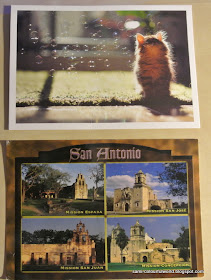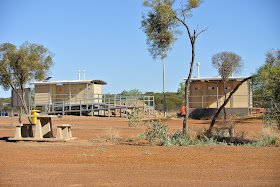Day 4 to Day 7 - CORAL BAY
We arrived in Coral Bay just in time to watch the sunset on the beach. The tide was low, and some of the tour boats were now resting on the sand instead of in the seawater.
 |
| Sunset seen from our accommodation |
 |
| The tour boats on the sand, when the tide is low |
We went into "Bayview Camping" to book our accomodation for 2 nights.
Our intention was to stay 2 nights and then go on to Exmouth 200km north, but on the second day we decided we had enough of travelling and would just stay there two extra nights.
The 2 bedroomed bayview villas facing the beach were beautiful and well furnished - lounge, two bedrooms (one double bed and 2 lots of bunk beds), lovely kitchen and bathroom. The cold water tap in the kitchen had potable water, otherwise the hot water and bathroom/shower water were salty.
We unpacked and the men went off to grill the meat we had in our cooler box (or esky in Australia).
That first night as we sat outside playing cards after dinner, a little black cat came to us, and started miawing. She was thin and hungry I presumed. We got her some canned tuna and water and she gobbled up all she could.
Pets were not permitted in the camping place, so the next day we queried at the office and at the two supermarkets if anyone had reported a lost cat, but no one knew.
One of the ladies suggested I call the ranger because it was probably a wild cat, but I couldn't do that, the cat was very friendly and seemed to enjoy our company, coming around whenever he saw us sitting outside on the deck, and would just miaw for food, then sit quietly until we went inside at bed time.
The last day I felt sorry to have to leave the cat behind, but we had a 2 day road trip ahead and we already have 5 cats at home. Hopefully he will be well cared for by other residents
 |
| The view from the grassed area of our Bayview accommodation |
 |
| The outdoor decked area of the cabins |
Coral Bay, about 1000km from Perth (more in our case as we went to Denham/Monkey Mia), is the gateway to the Ningaloo Reef. The clear turquoise beach waters are ideal for snorkelling, and fish and coral reef as visible not far from the shore.
There are paid activities like Whale watching, Coral viewing on Glass Bottom boats, kayaking, fishing expeditions...
The town is small, clean, has two caravan parks with plenty of cabins, one hotel (Ningaloo resort), a small building with accommodation for the local workers, a Youth Hostel, and a smattering of houses, two mini-markets, post office, bakery and fuel facility.
If you are visiting during peak months it would be wise to book ahead.
Prices are exorbitant, even comparing with the high Perth prices.
Fruit and vegetables are kept in the cold fridges in the supermarket, presumably to last longer - don't know if because they hardly sell them at those prices or to shield them from the heat?
In a coastal area famous for it's fish and fishing facilities I was amazed to find that fish (frozen not fresh either), cost about $60kg! We didn't fill up with petrol, but it cost $1.899/litre, the highest we had seen until then.
Our cabins, at $290 a night (slept 6) was almost double the price of a similar cabin we rented in a Geraldton caravan park, on our way back to Perth, for $160!
But of course we have to pay for the remoteness, the view and the fact that Coral Bay is in the Ningaloo reef area.

Ningaloo - an Aboriginal word that mean Promontory, which describes the projection of land that the coral reef skirts around.
The Ningaloo reef is over 250km long, from Coral Bay to Exmouth, further north. It's not as well know as the Great Barrier Reef on the East coast, but from the amount of foreigners I saw there, it must be getting a lot more overseas recognition...
The coral is just a few kilometres off the coast, with some as close as 100mt from the beach. (called fringing reef, unlike in the Great Barrier reef), and the marine life is rich with over 500 fish species and annual whale shark gathering.
In the morning when we got to the beach, hundreds of seagulls would mingle around the edge of the water picking on tiny fish, and as soon as we put our feet in the transparent water, they would scatter around our feet and dive into the sand...or at least that is what I thought was happening, as they would disappear in a flash.
When we walked further in, and we had "foot" for about 80 to 100 metres, we could spot a lot of bigger fish through the transparent water (sorry, don't know their type/name?) that seemed curious and swam around us. Once I even saw a Blue Spotted Ray as I walked in the water. It was amazing!
 |
| Seagulls at the end of the day - with their bellies full for sure. |
We had been recommended a great spot to go snorkelling just off the beach, so we walked south along the sand and water towards the very modern boat ramp/jetty, and half way there we saw the 5 knot sign (for the boats), and walked towards it. As long as the water is turquoise and crystal clear, you are able to stand, and when the water becomes dark blue means it's deeper.
Here we put our snorkel mask on and put our heads down to have a look around.
Well, we, doesn't include me.... I am not too comfortable in deeper water as I don't swim very well and cannot manage breathing under water, and I had trouble "stomaching" the rubber mouth piece. Every time I put that on I wanted to spew...so I lay on a kids body board that I had bought in the village shop, put the goggles on, and when my husband or daughter pointed somewhere, I would take a deep breath, put my head in the water, look around and bring my face up to breathe a minute later!
I still saw blue fish, Blue spotted ray, white fish, yellow fish with blue dots....and some brown coral too.
The current and wind brings you back to the north shore, so you have to keep swimming or in my case, kick my feet, to stay in the same area.
I felt sad not to be able to see as much as the family saw but I still felt very brave, as I'm not much of a swimmer.
After a short while I swam back to shore and walked north along the sand back to the main beach where we had left our beach things. Then I sat in the crystal clear waters covered up to my neck, and just stayed there with fish swimming around me.
The water was always so warm, it was heaven! Just my type of sea water. The Perth beach water is too cold for me and I just go in under duress, most times I just wet my feet.
 |
| Brown coral as seen in Coral Bay (photo from "Western Australia Travellers Guide) |
 |
| Coral Bay beach |
 |
| Seagulls doing their fishing |
 |
| The low tide with the boats almost in the sand. In the foreground one of the sun shelters |
 |
| Waters by the Boat Ramp |
 |
| The modern Boat Ramp |
On the second afternoon, we decided to go fishing for our dinner.
We went to Maud's Beach, 4km north and except for me, who sat reading a book, the rest of the family cast their lines, again and again....with no success!
After watching another beautiful sunset we went back home for another meat barbecue.
 |
| The family fishing at dusk |
 |
| Watching the sunset while the family cast their lines |
If we got to the beach early, we could get a shade canopy for the day. Otherwise there are a few trees or bring an umbrella. I was intrigued to see that the beach didn't have many people, even though the camping places were quite full, but a lot of people just sit outside their caravan reading, relaxing in the shade, go to the pool, go fishing...
The second fishing expedition was more bountiful, and after my husband cleaned the fish, we had a delicious fish barbecue with rice and salad I made.
At the end of the day I, along with dozens of people would go to the beach and watch the beautiful sunsets.
 |
| Sunset over Coral Bay beach, with the sun shelters in the distance |
On our last evening we decided to spoil ourselves with a dinner at "Finns Cafe".
Their menu on the blackboard was varied and we really enjoyed what we had. Bring your own liquor (you can buy it at the pub in the Resort). We had made no reservations, the restaurant was full, but managed to get a table. The staff was friendly and atmosphere was relaxed. Who wouldn't like working by the sea wearing shorts and flip-flops as a uniform?
Our 4 days just flew by, we enjoyed our wonderful stay but it was time to return home.
Next post - our return home.





















































